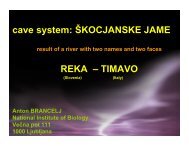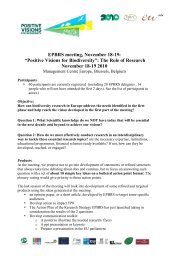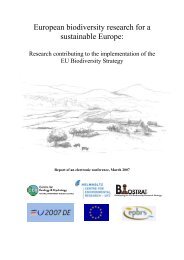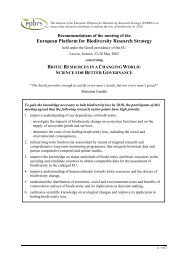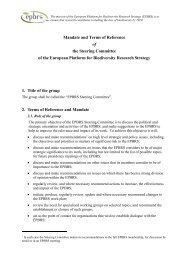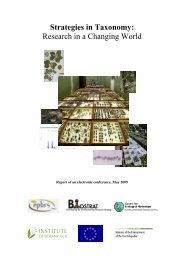Evaluation of the effectiveness of the New Instruments of ... - CORDIS
Evaluation of the effectiveness of the New Instruments of ... - CORDIS
Evaluation of the effectiveness of the New Instruments of ... - CORDIS
Create successful ePaper yourself
Turn your PDF publications into a flip-book with our unique Google optimized e-Paper software.
• The mismatch between <strong>the</strong> expectations <strong>of</strong> users and <strong>the</strong> reality <strong>of</strong> <strong>the</strong> first calls, <strong>the</strong><br />
evolving information material (see below), led to preparation costs for budgets and levels<br />
<strong>of</strong> funding that were not realistic.<br />
• The many proposals and consortia specifically developed for FP6 may, on <strong>the</strong> one hand,<br />
be pro<strong>of</strong> <strong>of</strong> success (e.g. demonstrating higher levels <strong>of</strong> ambition and integration) but, on<br />
<strong>the</strong> o<strong>the</strong>r hand, it also means that unsuccessful participants may loose most <strong>of</strong> <strong>the</strong>ir<br />
preparation work.<br />
• This problem is compounded by <strong>the</strong> fact that many specific Work Programme topics are<br />
only covered in one call. This means that failure to succeed in a specific call may result in<br />
failure to succeed in <strong>the</strong> whole <strong>of</strong> FP6.<br />
Statement from a participant 4 :<br />
“Although I liked <strong>the</strong> FP's a lot, I decided not to take part this time as <strong>the</strong> present<br />
programmes are too big. They require a big consortium and a big managerial effort. Being in<br />
industry, that is not what I want to take on my shoulders. This is beyond what I can justify.”<br />
Extract from <strong>the</strong> report on <strong>the</strong> survey among participants (annex 2):<br />
Proposers are pushed to put forward projects with a higher level <strong>of</strong> ambition and to involve more<br />
partners (from more countries) than <strong>the</strong>y would normally do.<br />
On <strong>the</strong> o<strong>the</strong>r hand, opinions <strong>of</strong> <strong>the</strong> co-ordinators seem to prove that <strong>the</strong>re are significant adverse<br />
effects, and that <strong>the</strong>ir behaviour as a reaction to <strong>the</strong> <strong>New</strong> <strong>Instruments</strong> is not necessarily <strong>the</strong> most<br />
adequate:<br />
Partnerships are enlarged artificially (<strong>the</strong> opinion <strong>of</strong> 61 % <strong>of</strong> <strong>the</strong> proposers), proposals may also be<br />
artificially adapted to fit work programmes, and scientific risk taking would not be stimulated.<br />
A constantly evolving communication from <strong>the</strong> Commission<br />
The efforts to ensure transparency that <strong>the</strong> European Commission pursues have led to<br />
‘evolving’ communication material being made available when decisions regarding<br />
implementation were not yet final. The consequences have sometimes been <strong>the</strong> creation <strong>of</strong><br />
false expectations and distorted perceptions among all stakeholders, including some <strong>of</strong> <strong>the</strong><br />
staff <strong>of</strong> <strong>the</strong> European Commission.<br />
Confusion about <strong>the</strong> efficient size <strong>of</strong> <strong>the</strong> <strong>New</strong> <strong>Instruments</strong><br />
Confusion has been created around <strong>the</strong> need for bigger projects. This is linked to <strong>the</strong> way <strong>the</strong><br />
Commission communicated during <strong>the</strong> launch <strong>of</strong> FP6 (see below), but also with <strong>the</strong> lack <strong>of</strong><br />
clarity <strong>of</strong> <strong>the</strong> definition <strong>of</strong> critical mass.<br />
The result is artificial enlargement <strong>of</strong> partnerships, way beyond <strong>the</strong> potential added value that<br />
can be created, sometimes leading to inefficiencies <strong>of</strong> scale and management problems.<br />
Projects <strong>of</strong> large size have specific problems. In addition to <strong>the</strong>se ‘natural’ problems related<br />
to size, <strong>the</strong>re are specificities <strong>of</strong> <strong>the</strong> <strong>New</strong> <strong>Instruments</strong>:<br />
o<br />
To maintain excellence is more difficult as size increases;<br />
4<br />
These statements are selected as ‘typical’ comments made by participants, to illustrate opinions as <strong>the</strong>y exist<br />
within <strong>the</strong> scientific and technological communities. They are not necessarily shared by <strong>the</strong> Panel members.<br />
11



